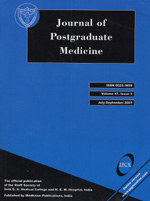
|
Journal of Postgraduate Medicine
Medknow Publications and Staff Society of Seth GS Medical College and KEM Hospital, Mumbai, India
ISSN: 0022-3859
EISSN: 0022-3859
Vol. 51, No. 1, 2005, pp. 9-12
|
 Bioline Code: jp05003
Bioline Code: jp05003
Full paper language: English
Document type: Research Article
Document available free of charge
|
|
|
Journal of Postgraduate Medicine, Vol. 51, No. 1, 2005, pp. 9-12
| en |
Irrational drug use in India: A prescription survey from Goa
Patel Vikram, Vaidya R., Naik D., Borker P
Abstract
BACKGROUND: There is concern regarding the irrational production, prescription and use of drugs in India. This study aimed to describe the quality of prescriptions by medical practitioners, including both the layout of the prescription and the type and number of drugs prescribed.
MATERIALS AND METHODS: A survey of all prescriptions dispensed at a busy pharmacy in the state of Goa, India, was carried out over a consecutive seven-day period. Each prescription was rated on the basis of a priori and pilot-tested variable list. The prescriptions by private practitioners were compared with those from practitioners in the public healthcare system.
RESULTS: Nine hundred and ninety prescriptions were collected. The majority (83.9%) were from private practitioners. The quality of the layout of the prescriptions was unsatisfactory: information to identify the practitioner was incomplete in more than a third of the prescriptions and information to identify the patient was incomplete in more than half. Clarity of written instructions on how to take the medicines was unsatisfactory in the majority of prescriptions. Polypharmacy was the norm, with more than half (52.7%) the prescriptions containing at least 3 medicines. Forty per cent of prescriptions included a vitamin or tonic preparation and a quarter of the prescriptions included an antibiotic and an analgesic. Over 90% of prescriptions contained only branded medicines. Private practitioners prescribed significantly greater number of medicines and were more likely to prescribe vitamins and antibiotics, and branded medicines.
DISCUSSION: This study confirms that the quality of prescriptions, both in terms of layout and the content of the drugs prescribed, is inadequate. There is a need to standardize the format of prescriptions in India so that all essential information is included. There is a need to strengthen an independent mechanism for continuing professional development of practitioners to ensure that patients are always given evidence-based, cost-effective treatments.
Keywords
Rational drug use, pharmacovigilance, survey
|
| |
© Copyright 2005 Journal of Postgraduate Medicine.
Alternative site location: http://www.jpgmonline.com
|
|
